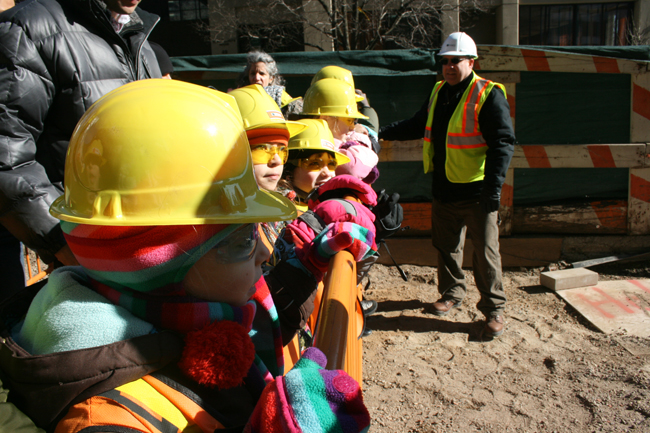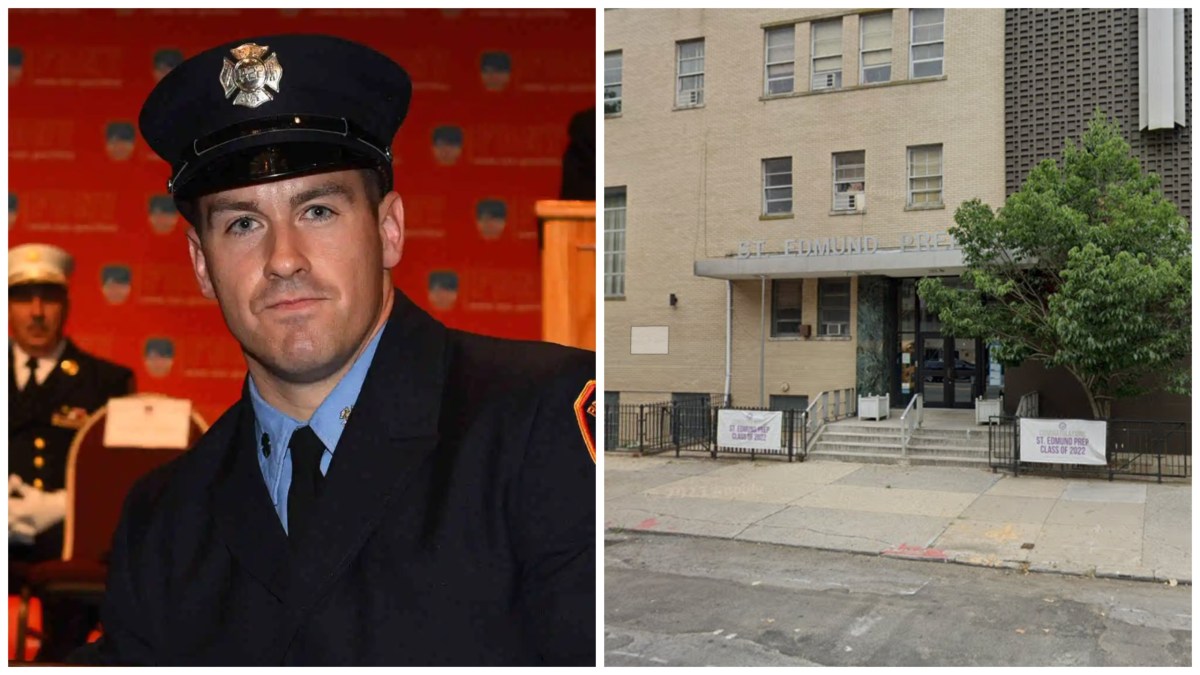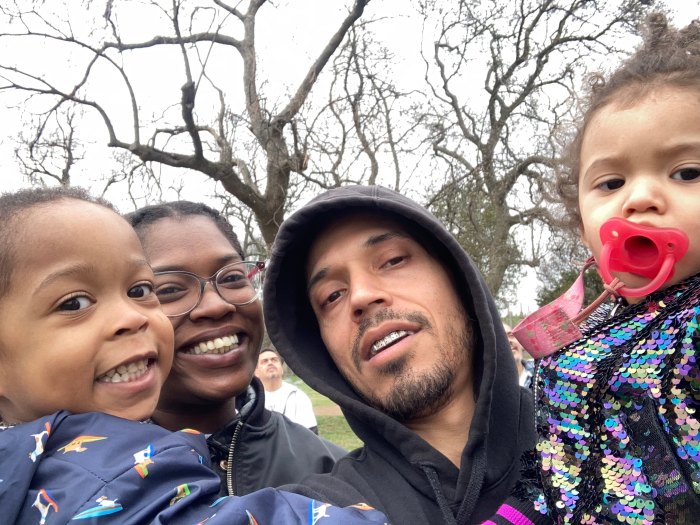
BY ALINE REYNOLDS | Downtown’s underground isn’t just made up of subway trains and tunnels.
It is also home to an intricate network of water mains and other pipes that help transport water from the Catskill Mountains to New Yorkers’ kitchens and bathrooms, second graders from P.S. 276 learned during a field trip to the South Street Seaport on Monday, Feb. 13.
The expedition, arranged by the city Department of Design and Construction as part of the city’s Neighborhood Infrastructure Curbside Education (N.I.C.E.) Program, fit neatly into the second graders’ social studies curriculum, which is focused on the evolution of New York City, according to the students’ teacher, Emily Schottland.
“There’s just so much you can learn from books and writing and reading about it,” said Schottland, “but to actually come [here] and see so concretely how it’s changing, it’s just such a great experience.”
Sporting junior-sized hardhats and bright orange construction vests, the children attended a safety demonstration at Peck Slip between Water and Front Streets, where workers were busy upgrading below- and above-ground infrastructure. The group then walked over to Fulton Street, where city engineer Joe Lione gave the students a tutorial on the city’s utility system.
“You guys are lucky – not many second graders get to come into a construction site,” Lione told the children during a break from replacing century-old water mains along Fulton Street.
Lione proudly announced to the children that his team uncovered one of the country’s very first electrical manholes at the site, then quickly delved into the city’s water system.
“Every time you turn on a faucet or your shower,” explained Lione, “water comes out of that pipe and into another pipe and comes into your house.”
“Ew!” several children exclaimed, peering into the hole.
“It’s not, ‘ew!’” Lione replied. “Inside, it’s nice and clean.”
Lione then asked, “Every time you flush the toilet, remember where does that water go?”
“Into the sewer!” a few students replied in chorus.
Tammy Meltzer-Kaufman, one of several second grade parents who accompanied their children on the tour, said the tour was an eye-opener for the second graders.
“To see the history and to be able to experience it by looking down and seeing the artifacts and seeing where the shoreline used to end, all of those things that are so easy not to know when they’re so tech-based these days,” said Meltzer-Kaufman, “brings history to a much more lively, physical aspect for them.
“I think it’s helping them get to learn about professions they don’t know much about,” chimed in class parent Christina Bhan. “What Alyssa’s doing is so inspirational for them. They can’t stop talking about it.”
Last month, archeologist Alyssa Loorya, who is overseeing the Fulton Street excavations, visited the P.S. 276 youngsters at their school to showcase a bone toothbrush, a stoneware bottle, a chamber pot and others of the 18th- and 19th-century artifacts she and her team recently uncovered. The Fulton Street project has been flagged for archeological digs, she explained, since it is located in a historic district.
“Remember all that stuff I brought to your classroom last month?” said Loorya. “We found that right behind you, underneath the ground.”
Alex Agran, Loorya’s colleague at her firm, Chrysalis Archeological Consultants, vividly described the excavation process to the children.
“Is it hot down there? How do you survive down there?” asked second grader Emmett Levine.
“It’s extraordinarily hot down there,” said Agran. “We had a lot of plastic buckets, and some of them were melting because of the heat. We have to wear proper clothing, drink a lot of water, and make sure to take breaks.”
“What is your favorite tool to use?” asked Jack Farber.
A pickaxe, replied Agran. “I use it to break rocks or brick walls or frozen ground.”
Farber followed up with, “Do you like the loud noise that it makes?”
“Yes,” Agran said, chuckling. “Very much so.”
Steps away at Peck Slip, the children got a run-down on basic safety precautions construction workers take when on duty.
Engineer Peter Roloff demonstrated a potential construction site hazard by lifting a box imaginatively full of heavy objects and dropping it on his colleague’s toe.
“Construction workers wear very special boots. The boot from the middle to the front is all made out of steel,” said Roloff.
“This time I know it won’t hurt him,” said Roloff as he smacked his co-worker’s boot with a hammer. “See? You’re toes are not going to get smushed.”
As they skipped to the 4/5 Fulton Street subway station en route back to school, the children shared fresh memories of their trip.
“I liked that they told you what you needed to do to be able to be a construction worker – what safety parts you need to do, and what pipes give you what type of energy, or telephone connection, or whatever,” said second grader Charlotte Newman. “It’s amazing how they’re able to fit all the pipes together under another pipe [without them] getting stuck!”

















